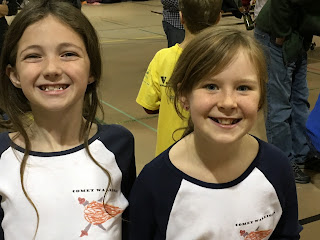We also made progress on our model African Serengeti. Tara and Macy got Google satellite images of the Serengeti and fitted them to our vibrating football table. Nick, Alyssa and Lais then took several pictures from above the table, pretending the camera was a plane flying over the ground below. They then used Autostitch, a program we used last year to fit microscope pictures together, to create a single bigger picture of the whole table:
With that job done we took pictures of Nick and stitched them together into a single bigger picture that I'm calling Nickenstein (this week's word).
The ability to put together small pictures into one big one will help us take closeup picture of animals and put them together into a picture of the whole area they cover.
Also last week we put together a list of jobs that needed to be done for our project and they included:
a) Fly the drone
b) Take pictures
c) Fit the pictures together
d) Train the computer to recognize the pictures
e) Count the animals in the pictures
f) Get pictures of model animals
You each voted for the top two things you might want to do and based on those votes we matched people to jobs. One thing we discovered since last week is that if you want to fly a drone for anything but the fun of it (and doing research in a school doesn't count as fun even if it is) then you have to be 18 years old. What that means is that flying the drone over a farm to take pictures of animals for our project can only be done by someone who's 18 or older. On the other hand, you can all fly the drone for fun, so that's what we're going to do. Let's hope for good weather at the end of the week!
Back to the jobs. With flying the drone for research not one of the choices any more, we divided things up as follows:
a) Fly the drone for fun: Everybody
b) Take pictures: Neshaya and Lais
c) Fit the pictures together: Lily and Lais
d) Train computer: Lily, Alyssa and Olivia
e) Count animals: Olivia and Hannah
f) Get pictures of model animals: Nick, Tara and Macy
Also, Alyssa volunteered to do another important task
g) Investigate regulations around flying drones: Alyssa
As we mentioned last week, one of the researchers Olivia emailed answered her back and was super helpful. He said:
Dear Olivia and the comet warriors,
Thanks for your email - it's great that you're trying to solve this problem. I put a folder in dropbox with some images from the wildebeest survey. The link to the folder is here (let me know if this doesn't work) -
There's also a blog article about how they perform the survey here -
The person who wrote that blog is Bryna Griffin, her email is bryna.griffin@fzs.org, and she might be able to provide you with more images of different animals and will probably be really interested in your research.
I should warn you I think what you're trying to do will be difficult. If you look at Fig. 2B in my paper you'll see that even people struggle to accurately count the wildebeest in these images! In my opinion the best way to improve the process is to focus on getting better information about the shape of the animal. You could do this by using a stereo camera or another technique known as structure from motion (https://en.wikipedia.org/wiki/Structure_from_motion ).
We've been trying to do this with a drone and testing it with cows too - I put some images from our tests in the dropbox folder. There's two images of cows taken at slightly different angles (im1.png and im2.png) and the height.png image shows the height of the cows by calculating the difference in movement of the pixels.
I hope this helps with your project but feel free to ask me any more questions
Good luck














